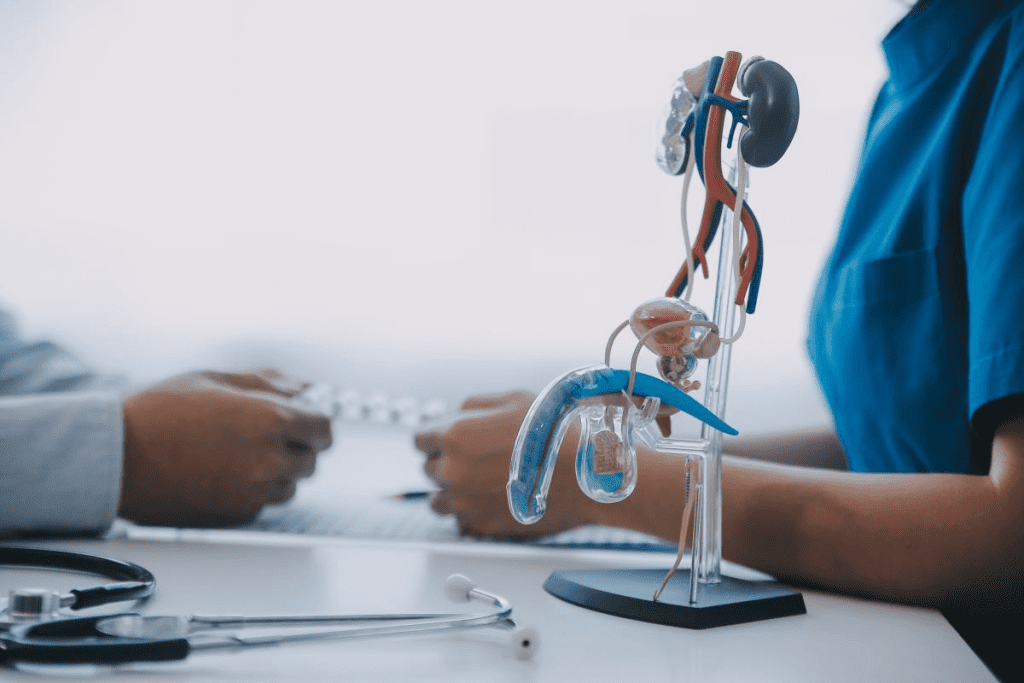Last Updated on November 25, 2025 by

Peyronie’s disease causes scar tissue in the penis, leading to curved, painful erections. A mild case has a curvature of less than 30 degrees. It also has minimal pain and little erectile dysfunction.
At our institution, we know a Peyronie’s disease diagnosis can worry you. But, most mild cases don’t get worse. They often stabilize in 3 to 12 months. Our team offers full care and support, addressing your concerns and helping you manage your condition.
Understanding Peyronie’s disease is key, including mild curvature and treatment options like tadalafil. We aim to provide top-notch healthcare. We also offer international patient support and guidance.
Mild Peyronie’s disease is diagnosed by certain signs. These include the degree of penile curvature, the size of the plaque, and if there’s induration.
A key sign of mild Peyronie’s disease is a penile curve of less than 30 degrees. The National Institute of Diabetes and Digestive and Kidney Diseases says this is important. Penile curvature greatly affects a patient’s life quality.
Mild Peyronie’s disease also has minimal plaque and induration. Plaque is a fibrous scar tissue that can curve the penis. In mild cases, this plaque is small, and the induration is not severe. We check these during a detailed evaluation to decide the best treatment.
It’s important to tell mild Peyronie’s disease from the more severe types. The treatment for moderate to severe cases is more intense. Our team uses a detailed assessment to figure out the right treatment for each patient.

Understanding the physical symptoms of mild Peyronie’s disease is key for managing it well. Patients with this condition face various symptoms that can affect their daily life.
Limited pain during erection is a main symptom of mild Peyronie’s disease. This pain worries many patients. We aim to help them manage this symptom. The Mayo Clinic notes that pain during erections is a common symptom.
In mild Peyronie’s disease, the condition barely affects penile girth. Patients often worry about their penis size. We offer support and advice on this issue. Remember, girth is the penis’s circumference, and changes can be a concern.
Mild Peyronie’s disease is also marked by the absence of hourglass deformity. This deformity, a narrowing of the penis, is rare in mild cases. We keep a close eye on patients and offer the right treatments.
The main symptoms of mild Peyronie’s disease are:

It’s important to know how common Peyronie’s disease is. This condition causes a curve and pain in the penis due to scar tissue. Studies have shown how often it affects adult men.
About 9-13% of adult males have Peyronie’s disease. This shows why it’s key to be aware and get a proper diagnosis. The National Institute of Diabetes and Digestive and Kidney Diseases says we need to help those affected.
The disease mostly affects men between 55-60 years old. Doctors need to know this to help diagnose and treat better. As men get older, the risk of Peyronie’s disease goes up, so it’s important for them to watch for symptoms.
Peyronie’s disease usually stabilizes in 3 to 12 months. Knowing this helps patients understand what to expect. “The stabilization period is a critical phase where the disease may progress, remain stable, or sometimes improve slightly,” says a leading urology expert. This helps plan the right treatment.
Learning more about Peyronie’s disease is important. Knowing its prevalence, age range, and how long it takes to stabilize helps us support patients better.
Mild Peyronie’s disease can deeply affect a man’s sexual health and overall well-being. It impacts physical health, mental state, and relationships.
In mild Peyronie’s disease, about 28% of men face erectile dysfunction (ED). Erectile function is key to sexual health. Any issues can cause distress.
The penis’s curvature, pain during erection, and anxiety can make it hard to get or keep an erection. We focus on treating ED, looking at both physical and mental sides. Medications like tadalafil can help manage symptoms and improve function.
The mental impact of Peyronie’s disease is significant. Around 19% of men with it feel depressed. This shows the need for care that covers mental health too.
Stress and anxiety from the condition can lower a man’s self-esteem and quality of life. We offer support that includes counseling to help men deal with the emotional side of Peyronie’s disease.
Peyronie’s disease can strain partner relationships, affecting intimacy and sexual function. It’s important for men and their partners to talk openly and understand each other. We encourage them to seek support together to manage the condition’s impact on their relationship.
By tackling the physical, mental, and relational sides of Peyronie’s disease, we aim to enhance the quality of life for those affected.
Getting an accurate diagnosis is key to managing mild Peyronie’s disease well. We suggest a detailed approach. This includes a thorough physical check-up and looking at the patient’s history to grasp the condition’s effects.
A physical exam is vital for diagnosing Peyronie’s disease. It lets us see how much the penis curves and if there’s a plaque. We also do a kink test to check the curvature when erect. This helps us figure out how severe it is.
If you have ongoing pain, a big curve, or trouble getting an erection, see a doctor. Early treatment can make symptoms better and improve your life quality.
We keep track of Peyronie’s disease progress with regular checks. This lets us tweak treatment plans as needed. Regular visits help us see changes in curvature, pain, and how well you can get an erection. This ensures your treatment keeps working.
Our monitoring includes:
By combining detailed diagnosis with ongoing checks, we offer tailored care for men with mild Peyronie’s disease. This improves their outcomes and life quality.
For people with mild Peyronie’s disease, tadalafil and other ED meds can help. We look at how these meds work, their benefits, and possible side effects.
Tadalafil is a type of ED medication. It helps improve blood flow to the penis. This can ease some symptoms of mild Peyronie’s disease, like ED. But remember, tadalafil doesn’t cure Peyronie’s disease. It just makes it easier to get an erection.
Other ED meds like sildenafil (Viagra) and vardenafil (Levitra) work like tadalafil. But they differ in how long they last and their side effects.
We think about these differences when picking ED meds for mild Peyronie’s disease.
Tadalafil and other ED meds are usually safe but can have side effects. Common ones include:
Talking to your doctor about your health and worries can help avoid side effects.
We stress the need to watch and adjust treatment plans as needed. This ensures the best results for our patients.
We offer various non-surgical treatments for mild Peyronie’s disease. Each treatment is tailored to meet the unique needs of our patients. Our goal is to manage symptoms, improve penile function, and enhance your overall quality of life.
Physical therapy, including traction devices, is a good option for mild Peyronie’s disease. Traction devices apply gentle, consistent stretching to the penis. This can help reduce curvature and improve length.
Our team will help you choose the right physical therapy plan. This may include exercises and the use of traction devices. We’ll regularly check on your progress to adjust the treatment as needed.
Vacuum therapy is another non-surgical method for mild Peyronie’s disease. It uses a vacuum device to improve blood flow and reduce curvature.
Vacuum therapy works well when combined with other treatments, like physical therapy or medication. Our specialists will decide if vacuum therapy is right for you.
In some cases, non-surgical treatments may not be enough. At this point, penile implants might be considered as a more invasive option.
Penile implants are usually for more severe cases or when other treatments don’t work. We’ll discuss the benefits and risks of penile implants with you, if needed.
It’s important to work closely with healthcare professionals to find the best treatment for you. By trying these non-surgical approaches, many men with mild Peyronie’s disease find relief from symptoms.
Managing mild Peyronie’s disease well needs a full plan. This includes getting the right diagnosis, treatment, and keeping an eye on progress. Studies show that treatments like collagenase clostridium histolyticum (CCH) and hyaluronic acid injections help. Research shows these can lessen penile curvature.
It’s key to have a treatment plan that covers all bases. This might include medicines, physical therapy, and changes in lifestyle. With the help of healthcare experts, patients can get better and live better lives. Our team is here to support and guide patients, helping them deal with issues like erectile dysfunction and penile curvature.
A mild case of Peyronie’s disease has a penile curvature of less than 30 degrees. It also has minimal pain and little erectile dysfunction.
A mild case of Peyronie’s disease is when the penile curvature is under 30 degrees. There is also little plaque and induration.
Patients with mild Peyronie’s disease may feel some pain during erections. The condition doesn’t greatly affect penile girth. They also don’t have an hourglass deformity.
Peyronie’s disease affects about 9-13% of adult males. It most often occurs between ages 55-60.
The condition usually stabilizes in 3 to 12 months.
In mild cases, about 28% of patients may have erectile dysfunction.
About 19% of patients with Peyronie’s disease may feel depressed.
We recommend a thorough physical examination for diagnosis.
Seek medical help if you have persistent pain, curvature, or erectile dysfunction.
Tadalafil can improve erectile function. It’s effective for mild cases.
We compare tadalafil’s benefits and side effects with other ED drugs. This helps find the best treatment for each patient.
We offer physical therapy, traction devices, and vacuum therapy for mild Peyronie’s disease.
In some cases, penile implants are considered for Peyronie’s disease treatment.
In mild cases, Peyronie’s disease has little effect on penile girth.
Hourglass syndrome is an hourglass deformity. It’s not common in mild Peyronie’s disease.
We compare tadalafil’s benefits and side effects with other ED drugs. This helps find the best treatment for each patient.
An erroneous or kink test is not a standard tool. We use a detailed evaluation to assess the condition’s severity.
Subscribe to our e-newsletter to stay informed about the latest innovations in the world of health and exclusive offers!